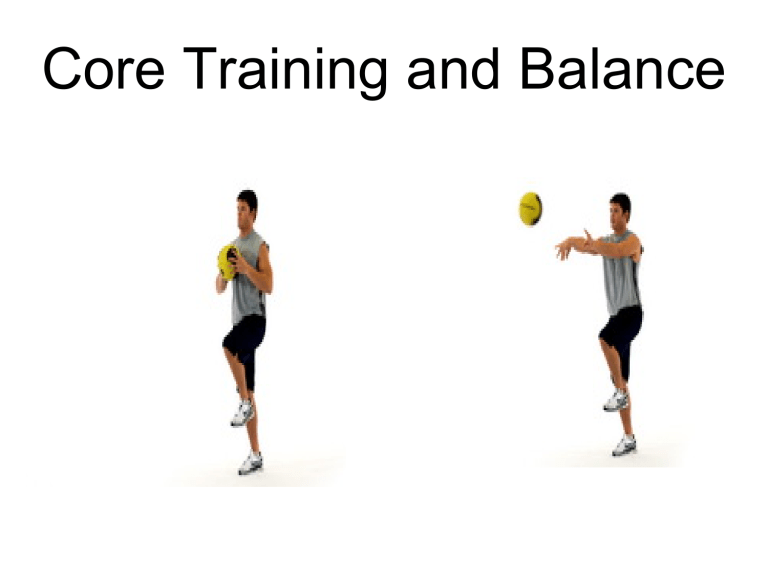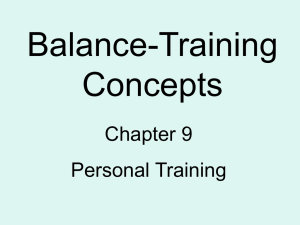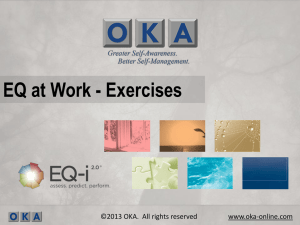Core_Training_and_Ba..

Core Training and Balance
The Core
• Defined as the lumbo-pelvic-hip complex, thoracic and cervical spine
• Where the body’s center of gravity is located
• Beginning point for movement
• Necessary for muscle balance and movement throughout the entire kinetic chain
The Core
• 29 muscles that attach to the lumbopelvic-hip complex
• Divided into two categories:
–Stabilization
–Movement
• Stabilization:
–Responsible for stability of the lumbopelvic-hip complex
• Movement:
–Responsible for movement of the core
The Core
• You must work the core from the inside out:
– Stabilization Movement
– This would be analogous to building a house without a foundation
– An individual must be stable first to move efficiently
Muscles of the Core
Stabilization
• Transverse
Abdominis
• Internal Oblique
• Multifidus
• Pelvic Floor Muscles
• Diaphragm
• Transversospinalis
Movement
• Rectus Abdominis
• External Oblique
• Latissimus Dorsi
• Erector Spinae
• Iliopsoas
• Hamstrings
• Hip Adductors
• Hip Abductors
Importance of Properly Training the
Core
• If the movement muscles are strong and the stabilization muscles are weak this will lead to compensation:
–Example: performing a lunge, squat, or overhead press with excessive spinal extension
–This results in unwanted motion of vertebrae and may lead to low back pain and injury
Importance of Properly Training the Core
• Performing abdominal exercises without stabilization has been shown to increase pressure on the disks and compressive forces on the lumbar spine
• Performing low back hyperextension exercises without stabilization has been shown to increase pressure on the disks to a dangerous level
• These unsupported exercises can cause damage to the ligaments supporting the vertebrae
• Fitness professionals must strengthen the stabilization muscles before the muscles that move the spine
Solutions For Stabilization
• Draw-In before core training:
–Pull in the region just below the naval toward the spine
• Maintain the cervical spine in neutral position during core training
• Do not allow the head to protrude forward during movement
• Maintain the eyes level during movement
Solutions to Stabilization
• The core stabilizing muscles consist primarily of slow-twitch, type 1 muscle fibers:
– They respond best to isometric contractions
– 6-20 seconds
Abdominal Drawing-In Maneuver
Designing a Core-Training Program
•There are three levels of core training:
–Stabilization
–Strength
–Power
Designing a Core-Training Program
• Execise Selection:
–Progressive:
• Simple to Complex
• Known to Unknown
• Stable to Unstable
–Systematic:
• Stabilization
• Strength
• Power
–Activity or Goal Specific
Designing a Core-Training Program
• Exercise Selection:
–Safe
–Proprioceptively Challenging:
• Stability Ball
• BOSU Ball
• Dyna Disk
• TRX
• Foam Roller
Designing A Core-Training Program
• Variables:
– Plane of motion:
• Sagital
• Frontal
• Transverse
• Type of Resistance
• Stability Ball
• Medicine Ball
• Cable
• Tubing
• Bands
• Dumbbells
Designing a Core-Training Program
• Variables:
–Body position - Speed of motion
• Supine - Duration
• Prone - Frequency
• Side-lying - Amount of Feedback
• Kneeling (fitness professional cues)
• Standing
• Staggered stance
• Standing on an unstable surface
Stabilization
• Exercise involves little motion through the spine and pelvis
• These exercises are designed to improve the stabilization muscles
• Exercises include:
–Quadruped Drawing In
–Posterior Pelvic Tilt
–Supine Bridge
–Prone Plank
Strength
• Core-strength exercises involve more dynamic eccentric and concentric movements of the spine throughout a full range of motion
• Exercises include:
–Cable/Tube Rotations (high-to-low, lowto-high, and 90 degrees)
–Push-Up (SB, TRX, BOSU, MB)
–Supine Row (SB, TRX)
–Jackknife (SB, TRX)
Power
• Core-power training exercises are designed to generate force
• Exercises include:
–MB Chest Pass
–MB Chest Pass to a Burpee
–Tube Running
–Lateral Tube Running
Core Training Program Design
• Stabilization:
–1-4 exercises
–1-3 sets
–12-20 reps
–Slow tempo (4/2/1)
–0-90 sec rest
Core Training Program Design
• Strength:
–1-4 exercises
–2-3 sets
–8-12 reps
–Moderate tempo (3/2/1)
–0-60 sec rest
Core Training Program Design
• Power:
–1-2 exercises
–2-3 sets
–8-12 reps
–Fast but controlled tempo
–0-60 sec rest
The Importance of Balance
• Whether walking down stairs, supine on a stability ball, or playing basketball, balance is key to all functional movements
• Balance should constantly stress an individual’s limits of stability
• An individual’s limit of stability is the distance outside of the base of support that he or she can go without losing control of their center of gravity
The Importance of Balance
• Training functional movements in a proprioceptively rich environment
(unstable yet controllable), with appropriate progressions facilitates maximal sensory input to the central nervous system
• Balance training focuses on functional movement in a multisensory, unstable environment
Goals of Balance Training
• Improves joint stabilization:
–Ability of the kinetic chain to stabilize a joint during movement
• Examples:
–Rotator cuff stabilizing the head of the humerus while performing a push-up
–The hip abductors and adductors stabilizing while performing a squat
Goals of Balance Training
• Continually increase the client’s awareness of his or her limit of stability or kinesthetic awareness by creating controlled instability
• Example:
– A 65-year-old client balancing on one foot on the floor
– A 25-year-old client balancing on one foot on a BOSU
Designing a Balance-Training Program
• Three levels of balance training:
–Stabilization
–Strength
–Power
Designing a Balance-Training Program
• Exercise Selection:
–Safe
–Progressive:
• Simple to complex
• Known to unknown
• Stable to unstable
• Static to dynamic
• Bilateral to unilateral
• Eyes open to eyes closed
Designing a Balance-Training Program
• Exercise Selection:
–Safe
–Proprioceptively Challenging:
•Floor
•Stability Ball
•Dyna Disk
•BOSU
•TRX
Designing a Balance-Training Program
• Variables:
– Planes of motion
• Sagital
• Frontal
• Transverse
– Types of resistance:
• Body weight
• Dumbbells
• Tubing
• Bands
• Cable
Designing a Balance-Training Program
• Variables:
– Body position:
• Two-Legs Stable
• Single-Leg Stable
• Two-Legs Unstable
• Single-Leg Unstable
– Speed of motion
– Duration
– Frequency
– Amount of feedback
• Visual, Verbal, and Tactile Cueing
Stabilization
• Exercises involve little joint motion
• They are designed to improve joint stabilization
• Example Exercises:
– Single-Leg Balance
– Single-Leg Balance with Eyes Closed
– Single-Leg Balance Reach
– Single-Leg Balance on Disk
– Single-Leg Balance on Disk
Strength
• More dynamic eccentric and concentric movements
• Movements involve dynamic control in mid-range of motion, with isometric stabilization at the end-range of motion
• Example Exercises:
– Single-Leg Squat
– Single-Leg Squat and Reach
– Single-Leg Deadlift
– Step-Up to Balance
– Lunge to Balance
Power
• Exercises are designed to develop high levels of eccentric strength, dynamic neuromuscular efficiency, and reactive joint stabilization
• Exercise examples:
–Squat jump with stabilization
–Multiplanar hop with stabilization
–Single-Leg hop with stabilization
Balance Training Program Design
• Stabilization
–1-4 exercises
–1-3 sets
–12-20 reps
–Slow tempo (4/2/1)
–0-90 sec rest
Balance Training Program Design
• Strength:
– 1-4 exercises
– 2-3 sets
– 8-12 reps
– Moderate tempo (3/2/1)
– 0-60 sec rest
Balance Training Program Design
• Power:
–1-2 exercises
–2-3 sets
–8-12 reps
–Controlled-hold the landing position for
3-5 sec
–0-60 sec rest








